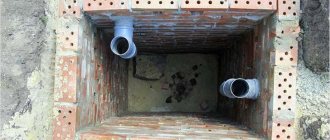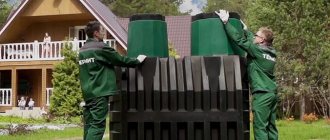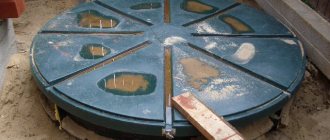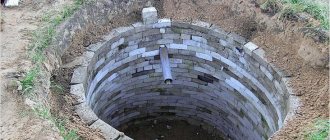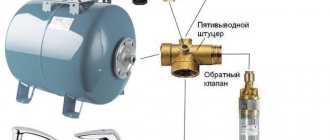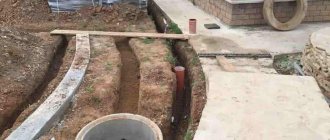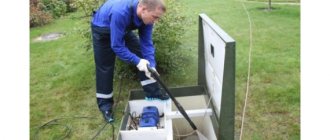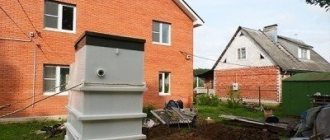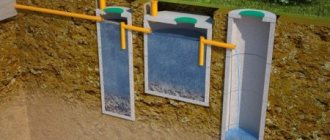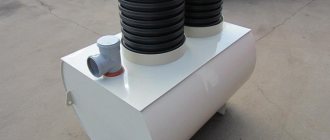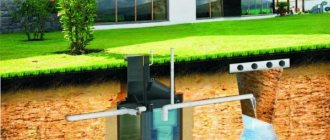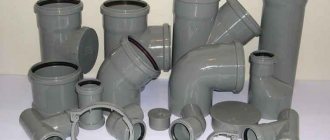Main water supply and a central sewer system often remain an unaffordable luxury for owners of summer cottages and country houses, but they still have to solve the problem of sewerage. If earlier the owners built ordinary, imperfect cesspools, now they have been replaced by “civilized” structures - septic tanks, convenient, sealed, efficient, and absolutely safe for the environment. If owners are thinking about organizing a high-quality treatment system, then it does not hurt them to seriously study the question of what such a device is and get acquainted with its types. It is better to find out in advance how a septic tank for a private home works, and also look at possible installation plans for the treatment structure.
Scheme of the device and principle of operation of the septic tank
When considering the design and principle of operation of the sump, it turns out that all treatment facilities have much in common.
Most autonomous sewage systems are combined containers for the gradual purification of waste and the production of sediment in the form of insoluble particles of various inclusions.
Tanks are made from various materials (reinforced concrete rings, car tires, bricks, flat slate). They are also made in different configurations.
Principle of operation
The operating principle of a septic tank, equipped according to all the rules, is a complex scheme, as a result of which the negative impact on the soil and the environment is minimized. According to the traditional scheme, a septic tank is a treatment facility, and it looks like a device of two or three chambers. The first container is a storage facility for waste directly from the sewer line.
This is where the mixture decomposes. In the chamber, the wastewater breaks down under the action of bacteria into a sludgy substance and settled water.
IMPORTANT! The first tank should be of such a volume that it is enough for use for three days, during which the mass decomposes.
After the water has settled and purified a little, it flows into the second chamber - the filtration well. If the first container is made hermetically according to SNiP, then the second one must be made with a drainage bottom (crushed stone, gravel or sand). Water passes through the drainage, is filtered and absorbed into the ground, thereby not polluting it.
Scheme of a simple septic tank with soil-based wastewater treatment Source roomester.ru
Basic diagrams of popular models
Manufacturers of autonomous sewer systems are improving technology, so they offer the user many convenient options. The more filtration cycles, the better the result.
Tank – comprehensive cleaning with infiltrator
Tank septic tank scheme - comprehensive cleaning with an infiltrator.
A popular septic tank with a soil treatment design. A plastic tank with rigid ribs can be installed in any soil. The system consists of removable units, so an additional module can be added if necessary.
The Tank cycle is “classical” biological filtration. In the first tank, mechanical separation of sewage occurs. In the second container, anaerobes are broken down into simple compounds.
Two-chamber models complete the work in an infiltrator, and versions with 3 components are subjected to additional bacterial treatment.
Topas – multi-stage biofiltration
The vertical septic tank is divided into 4 sectors, between which wastewater circulates. The components are connected to each other by hoses. A pipe pump transfers purified liquid, dirt, and debris from one part to another. The device runs on electricity.
In the first sector, aerobic microbes decompose wastewater into light components. In the next compartment, the water is removed from small particles. In the settling tank, sewage is converted into sludge. The last chamber accumulates pure liquid. If the tank is full, the equipment warns the owner with a signal.
Triton – non-volatile cleaning system
An inexpensive model without pumping will not take up much space on the site. The unit carries out rough and biological separation, and additionally performs soil purification. The equipment consists of 2 containers, which are connected by pipes. The liquid settles in the first tank and gradually flows into the second. The proprietary infiltrate treats water with bacteria.
Ecopan - six-stage wastewater filtration
Ecopan septic tank scheme - six-stage filtration of wastewater.
The device consists of 6 parts, each of which contains complex processes:
- separation;
- anaerobic treatment;
- aerobic digestion;
- cleaning with a dolomite bioreactor;
- removal of sediments.
Liquid accumulates in the storage tank, which can be used for technical purposes. 3 settling tanks provide high-quality removal of impurities.
Microbes need oxygen to live, so the model is connected to electricity.
Rodlex - storage type septic tank
The sewer tank works on the principle of a cesspool. The hollow tank with legs and screw neck is made of durable polymer material that will last at least 50 years. Seamless technology ensures a sealed housing. The special shape of the tank allows it to withstand soil pressure.
The septic tank model is buried to a depth of 2.5 m, and drain pipes are connected. To prevent sewage from spilling, you need to install a rubber cuff lubricated with silicone sealant at the entry point of the hose. The capacity of the device is 4000 liters, so you need to periodically pump out the liquid.
Fast – aerobic recycling technology
A vertical type self-regulating apparatus quickly processes waste. In the receiver, aerobic bacteria act on the wastewater. The fan supplies oxygen, increasing the rate of breakdown into water and sediment. The airlift moves the liquid to the segment with anaerobes, where clarification occurs and the pure residue is released.
The Fast septic tank adapts to wastewater with chemical additions and large parts. Under the influence of an aggressive environment, microorganisms die. The cellular structure of the module protects useful components from destruction and creates favorable conditions for development. The self-regulating system does not take up much space on the site.
A septic tank is a modern autonomous sewer system that will provide comfort in a country house. Models differ in operating principles, installation complexity and price, so you can choose the appropriate option to suit your needs. Popular types are easy to use and will serve property owners for decades.
Advantages and disadvantages of septic tanks
Depending on how the septic tank is designed, the family’s living conditions will radically improve, and this will be the main advantage of such a treatment facility. Besides, it has many other advantages. Let's look at them in more detail:
- Long service life.
- There are no unpleasant odors in the local area.
- There is no need to order a sewer truck often.
- The risks of soil contamination are significantly reduced.
- Easy and reliable installation. When constructing them, ready-made septic tanks “Termite storage tanks” or “Tank” are also used - stations for complete decomposition of waste.
The disadvantages of settling tanks include the large volume of excavation work during installation and the high cost of polymer septic tanks.
Septic tank or cesspool: nuances of choice
In a modern home, a large volume of water is consumed for domestic needs, which requires disposal. When installing a sewerage system, you first have to choose between a simple cesspool and a septic tank. What problems do you face when choosing? Let's look at these nuances in more detail:
Disposal rules . A cesspool is a simple storage facility for waste, and it is stored there until the storage facility overflows.
To clean the cesspool, you will need regular services of a sewer truck Source dom-expert.by
The larger the family composition and water distribution devices, the greater the water consumption. The design of the septic tank allows it to be used not for storage, but for waste treatment, while 70–80% of wastewater is recycled.
Number of tanks . A cesspool is a single storage facility - a classic septic tank includes two or three chambers.
Service . You need to pump out the contents from the pit as it fills. The septic tank needs to be cleaned much less frequently, no more than once a year.
Frequency of use . If a treatment plant is needed at a dacha where there is seasonal residence, then there is probably no point in installing a large-scale and more financially expensive septic tank. A cesspool will be enough.
See also: Catalog of companies that specialize in water supply and sewerage.
Criterias of choice
When choosing a ready-made septic tank or calculating the performance of a home-made system, you should determine the intensity of sewer use. The total volume of the tanks depends on the number of people and the seasonality of living in the house.
You should also inquire in advance about the characteristics of the soil on the site, since installations with filtration wells will only work on light sandy and sandy loam soils. The presence of a retaining clay layer or a high occurrence of water is already a reason to abandon septic tanks with the removal of wastewater for further treatment. In this case, it is easier to purchase a more efficient VOC, from which water can be pumped into the nearest reservoir or used for technical needs.
When choosing the size of a septic tank or local treatment station, the depth of soil freezing in a particular region is also taken into account - working tanks are installed below this mark. In the southern regions, it is better to take horizontally oriented tanks; vertical ones are used in areas where the soil freezes to 1.5–2 m.
For a private home with permanent residence
In a house with permanent residence, the sewage system is constantly used, so it fills up quickly. To avoid sponsoring sewer trucks once again, choose an installation with a minimum percentage of non-degradable residue. High-performance stations with biotreatment and internal aeration are best suited for this. These are the “twins” Topas and Topol, expensive systems like FAST or the budget Diamond.
Topas septic tank installation
It is allowed to use septic tanks with the discharge of pre-clarified wastewater into the filtration field. But only if the area is large and it is possible to place the drainage away from buildings, wells and plantings. The height of groundwater and soil composition are also taken into account, as discussed above. If the aquifers are closer than 2–2.5 m, you will have to return to the more expensive VOC option.
For the dacha
When a country house is used only for seasonal living, there is no need for a complex treatment system. In addition, without constant replenishment, microorganisms in the reservoirs of active septic tanks will die, and restoring their colony will take two weeks and at least 1–1.5 thousand rubles. If a family lives in a country house for one or two seasons, it makes sense to install a septic tank with post-treatment in soil such as Terra-Practik, Termite or the same Tank.
For rare and irregular visits, the choice is simplified - just connect a storage tank to the sewer and empty it of its contents as it fills. Just think about where to install the barrel so that the sewer truck can drive up to it.
Any developer, when improving a country house, sooner or later is puzzled by the question of how to install a local sewer system. Modern technologies will solve this issue in several ways, including a treatment station, a septic tank made of concrete rings, and so on. But to choose the optimal option, a comprehensive solution is needed.
Septic tanks with soil post-treatment of domestic wastewater
The operation of a local treatment plant depends on the conditions for processing household waste. In this regard, septic tanks can be divided into two types: with ground filtration; with complete biological purification.
After biotreatment, the water can be drained into a drainage well Source vipmods.ru
Let's take a closer look at what the difference between them is.
Wastewater treatment plants with soil treatment
The operation of a septic tank with natural filtration is based on gravity. It is well known that any household waste consists of 90-95% water.
The remaining five percent are impurities that, after settling, settle to the bottom of the mixture. Septic tanks consisting of two or three chambers operate on this principle.
In the first case, waste filtration occurs in the second chamber through a crushed stone layer, and in another option, final purification through the soil occurs in a third container or on a specially created filtration field (if the groundwater is high).
Septic tanks with complete biological purification
Such complete purification methods achieve the greatest effect, since they are based on the breakdown of substances under the influence of biological enzymes.
Waste processing in such a treatment plant directly depends on the active work of microorganisms. In this regard, constant monitoring of the process is necessary to prevent the death of living bacteria.
Components of a septic tank
All treatment structures consist of:
- Tank for settling wastewater. Such containers are most often made of plastic or metal. If you build a septic tank with your own hands, then such a tank is built underground from concrete or brick.
- Pipeline: incoming and outgoing. The drainage overflow pipes are installed at a slope so that the liquid flows smoothly between the tanks.
- Maintenance elements: wells and hatches. There must be at least 1 well on the external route of the sewerage pipeline. If the length of the structure exceeds 25 meters, there should be 2 wells.
- Ventilation system. It is necessary for air exchange, which ensures the maintenance of the desired temperature, the removal of methane and the normal functioning of microorganisms. The simplest ventilation is constructed from 2 risers: 1 is installed at the beginning of the sewer system, 2 - at the outermost section of the septic tank.
Design and preparatory activities
The main requests for the installation of septic tanks are indicated in SNiP (building codes and regulations). Before starting the installation of a treatment plant, it is necessary to coordinate the project with the sanitary and epidemiological station (SES), otherwise the costs may be in vain.
Standards governing the placement of a septic tank on a site Source optopg.ru
When developing a project for installing a septic tank, first of all you need to take into account the requirements of SNiP and SES, and they inform about the following:
- The shortest distance to the building is 5 m.
- The distance to the nearest water intake (well, borehole) is 50 m.
- Distance to running water (river, stream) – 10 m.
- The interval to a source with standing water is 30 m.
To competently draw up a project for a septic tank, you need to imagine the prices for installation work, and also know the approximate prices of materials. In addition to this cost, one must take into account the cost of earthworks, which are inevitable for such a treatment facility.
Preparatory work
Before you begin installing the septic tank, you need to make preparations. It involves excavation work and calculation of parameters that influence the correct choice of location and efficiency of the treatment plant.
Preparatory work includes:
- Analysis of the soil structure and topography of the planned site for a septic tank.
- Checking the depth of groundwater. The depth of the installation, as well as the filtration method, depend on this parameter.
When groundwater is high, the design of a volatile septic tank with a drainage pump is most often used. Source tvoy-septik.ru
- Preparing the site for the future septic tank. (Cleaning the area from foreign objects).
- Marking.
- Digging a hole for a structure and trenches for sewer pipes.
After the pit has been dug with dimensions for installation, installation can begin.
Correct septic tank on an area with high groundwater level
In some cases, it makes sense to install a sealed storage tank. This is a kind of analogue of a cesspool. Its peculiarity is that the liquid only accumulates in the container, but is not purified.
Disadvantages: the need for frequent maintenance and high cost. On the other hand, if people do not live in the house permanently, such a sewer system will be profitable and convenient.
Industrial storage septic tanks are made from high-strength materials. The thickness of the tank walls can reach 10-40 mm. There are large volume septic tanks.
Their advantages:
- absolute tightness;
- environmental safety;
- ease of installation;
- durability.
Some models are equipped with sensors that indicate how full the container is.
You can use plastic or fiberglass containers as storage tanks or build a tank from monolithic concrete. You will have to clean them about once a month.
In most cases, the drive does not solve the problem, because... For a comfortable life, home owners need a complete sewer system. In this case, it makes sense to equip a septic tank with a bulk aeration field. The structure must be waterproof. It must be protected from floating and deformation due to soil heaving.
Features of materials for making cameras
There are several suitable materials for constructing a septic tank with high groundwater:
- Reinforced concrete . A volumetric monolithic structure made of reinforced concrete is an ideal option for a house where a family of 3 or more people lives. The chambers of such a septic tank do not allow water to pass through, do not float up, cope with the effects of aggressive chemicals and can last for decades.
- Plastic (containers or Eurocubes). Not the most reliable material, but it is suitable for independently installing a septic tank in the country. Pros: tightness, lightness. Disadvantages - the need to provide good protection against floating, the risk of cracks appearing when the soil heaves.
- Fiberglass . The material is highly durable, lightweight, can withstand heavy loads, and withstands chemicals well. The disadvantage is the same as that of plastic: the septic tank must be anchored during installation.
To install a reliable sewerage system, it is best to choose reinforced concrete. The construction of such a septic tank will be quite expensive, but you can forget about the problem of floating.
The structure will not burst if a vehicle accidentally hits it, as can happen with a plastic or fiberglass tank. It is extremely durable and repairable.
Protecting the septic tank from floating and heaving of the soil
Lightweight plastic septic tanks must be fixed, because their weight is not enough to withstand groundwater pressure. They often float up. The technology of anchoring the structure itself is simple, the main thing is to strictly adhere to it.
Work order:
- The bottom of the pit is leveled . A 30 cm thick sand cushion is poured on top and compacted thoroughly.
- A base is placed on a layer of sand - a reinforced concrete slab according to the size of the structure.
- The septic tank is mounted on a slab , secured with special belts or cables.
To protect against soil heaving, use a dry mixture of sand and cement (5: 1). After installing the septic tank, a gap remains between the structure body and the walls of the pit.
It is desirable that it be at least 15 cm. The mixture is poured into this space in layers, pouring water and compacting each layer.
Instead of a finished slab, you can use a homemade base. To do this, the bottom of the pit is filled with concrete and powerful metal loops are installed for fastenings
During backfilling, the septic tank tanks are simultaneously filled with water. Moreover, the water level must coincide with the filling level of the pit. This is necessary to equalize the loads and prevent cracks from appearing in the plastic structure.
The device of the above-ground filter cassette
If the groundwater lies deep, either a filtration field or a filter well is installed for post-treatment of wastewater. In this case, the water moves by gravity, there is no need for forced pumping.
If the groundwater level is high, you need to install an additional waterproof well, pump and filter cassette. Its size is calculated based on the fact that for cleaning 0.5 cubic meters. you need a 1 x 1 m cassette.
Water from the septic tank enters a separate well, from where it is lifted using a pump and supplied to the filter cassette (+)
To set up a filter cassette, 30-40 cm of soil is removed from the entire surface of the future structure, and the perimeter is fenced with concrete blocks so that their height is level with the ground.
This space is filled with crushed stone (fraction from 20 to 40 mm), and a tank without a bottom is placed on top, under which a pipe from the septic tank is connected. The structure is insulated and covered with a layer of soil 30 cm thick.
Installation of septic tanks: some advice from professionals
Let's consider what difficulties may arise when installing a finished septic tank. First, you need to select a reliable, competent installation company that will install the treatment facility.
Secondly, take into account what material the septic tank is made of - propylene or polyethylene, and what the thickness of the walls is. Thirdly, it is necessary to inquire not only about the price of the equipment and the cost of installation, but also the cost of maintaining the service (the cost of pumping out).
It is advisable to purchase septic tanks from well-known brands, since in this case you can hope that both spare parts and a service company are available in the given region.
To determine the size of the septic tank, you need to take into account, first of all, the number of water taps installed in the house and the one-time discharge of water.
If a small number of people live in the house, then you can consider the option of a small septic tank of the “Kid” type Source microles.ru
What the consumer needs to know
Aeration VOCs do not allow volley discharge of wastewater (more than 100 l/h). For example, if there are often guests in the house, the flow of waste water (bathing, showering, etc.) increases sharply, due to which the colony of bacteria used for cleaning is partially (or completely) washed away. And therefore, for some time after the salvo discharge, the installation will not be able to purify wastewater to the indicators specified in the passport. A long-term power outage also negatively affects the operation of systems of the first type, namely, it leads to partial or complete death of the bacterial colony. True, some notify the buyer about this. Others argue that this is not a significant drawback of the devices, because you just need to place store-bought bacteria for septic tanks in a container, and the installation will begin to function as before. This is indeed true, but in this case the degree of wastewater purification declared by the manufacturer will not occur earlier than in two to three weeks.
But for complex VOCs, neither a salvo discharge nor a power outage threatens with negative consequences. The reason for this is the design differences between installations of the first and second types. The fact is that in aeration VOCs, aerobic and anaerobic processes occur in one volume, where due to aeration there is constant mixing of activated sludge. In complex VOCs, sedimentation of sludge occurs in a separate chamber, where it is in a state of relative rest, and since bacteria in such systems live not only in the water, but also in the bioreactor, they are not in danger of being washed out by abnormal wastewater, nor are they in danger of dying due to shutdown electricity. Even with a long interruption in power supply, bacteria on the biofilter are alive for three months. Reaching the operating mode declared by the manufacturer occurs 4-10 days after the installation is launched.
Household waste (toilet paper, hygiene items) should not enter the aeration installations, as this can lead to clogging of the pumps that ensure the operation of the station. In addition, it is not advisable to discharge chemical household detergents into it, which worsen the conditions necessary for the life of bacteria. But complex installations are more “loyal” to these factors, mainly due to their design features. Household waste that gets into them (toilet paper, napkins, food debris, pet hair, polymer films) remains in the settling chamber and cannot penetrate into the section where the pumps are located. A small amount of chlorine-containing preparations (washing powder, bleaches), which entered the second type VOC along with water, will also not lead to loss of system functionality.
Both types of devices are energy-dependent - the compressor (pump) must operate in continuous mode. However, complex VOCs have slightly lower electricity consumption due to the fact that they do not use a compressor, but a pump operating on a timer (15 min./on - 15 min./off).
The Russian market offers systems of varying complexity from both domestic and foreign manufacturers. In some of them, the cleaning process is controlled by a programmable controller, which changes the operating mode of the installation based on the amount of incoming wastewater. If there are few of them, the controller switches the system to an economical mode, and in case of salvo resets, to a forced one. Although automation simplifies the operation of the system, it significantly increases the price of VOC and its further maintenance.
How is wastewater cleaned in a septic tank?
Various purification schemes are used to filter wastewater.
Traditional scheme
A classic septic tank is a three-chamber tank. The first two tanks are sealed, and anaerobic (without air access) decomposition of wastewater occurs in them.
Purified, the water gradually flows through overflow pipes into the third - filtration well, in which it passes through a layer of crushed stone and is absorbed into the ground.
ON A NOTE! Since gas is released during the decomposition of organic substances, the settling chambers are equipped with ventilation pipes.
Classic scheme of a septic tank Source prostroyer.ru
Scheme with a filtration platform
This method is used in cases of high groundwater levels. In this septic tank, the substance also decomposes into smaller fractions, resulting in a sludgy mixture.
But the purified water does not go into the well, but is forcibly pumped out by pumps to the filtration field, which are trenches dug at the top, covered with rubble.
Using a biofilter to filter household waste
A simple biofilter is a reservoir filled with drainage material. Such a filter can be plastic “ruffs”, expanded clay, or crushed stone. But the main condition for successful cleaning here is a large area, since such an area is necessary for the settlement of colonies of microorganisms.
And with this method, wastewater treatment occurs up to 95% instead of 85% in the previous septic tank. Here, pre-purified water enters the biofilter from above, passes through drainage, and simultaneously undergoes mechanical and biological treatment.
At home
The first step is to use the so-called self-cleaning attempt. It is ideal if you have a drain clog due to greasy substances being drained into your pipes. They can settle on the walls, thereby blocking normal drainage.
What is the best way to clean sewer pipes?
In this case, boil a bucket of water and simply pour it through the hole in the sink. For most reasons this will be sufficient.
If this method does not work for you, try using the safest and easiest to use cleaning product - a plunger.
The technology is very simple:
- Completely cover the hole for draining the water with the bowl of the plunger so that no air gets into it, and if it does, then as little as possible.
- Fill the bathtub or sink with water so that it completely covers the bowl.
- Check to see if water is leaking under the plunger. If not, you can start cleaning.
- To do this, make 10-20 sharp vertical movements (pushes) using the handle at a slight angle, then quickly remove the plunger from the water.
If the water quietly seeped inside, it means the cleaning was successful.
If the blockage still does not go away, you should try again a few more times. If they were unsuccessful, alas, self-cleaning will not help and you will have to resort to more radical solutions for cleaning sewer pipes using chemicals.
How to clean a sewer pipe in a private house?
Cleaning a sewer in a private house is no different from regular cleaning in an apartment; the only distinguishing condition will be the ability to clean pipes outside the house if you have a sewer plan. By analyzing several possibly clogged areas, there is a chance to more accurately determine the area where the waste stagnation occurred.
Next, all the same cleaning methods and options are used as in the apartment.
Video description
See the video about a septic tank with a biofilter:
Forced aeration
If a septic tank is equipped with an aeration chamber, it turns from a traditional settling tank into a biological treatment unit. Such a station is designed to provide the highest quality of filtration, therefore such a treatment facility does not require either a well or a filtration site.
Basically, purification here takes place in an aeration tank. The symbiosis of aerobic bacteria effectively decomposes organic matter by dividing complex compounds into simple ones. This septic tank does not need to be cleaned using a sewer truck: they are provided with additional fecal pumps for pumping out the sludge.
Cleaning must be done at least once a quarter, otherwise the pump may silt up, stop working, and the station will fail.
Operating the system in winter
If, before installing a treatment system, you are puzzled by the question of how a septic tank works in winter, then you should take a closer look at the information below. In order for the equipment to continue to function effectively, the tank, filtration fields and pipes should be buried at the ground freezing line or insulated. In this case, you will not have to worry about the correct operation of the system in winter.
The user should remember that the septic tank must be operated continuously. Otherwise, without additional insulation, it cannot be guaranteed that the sewer will not freeze. Everything can thaw only in the spring. In order to protect yourself, you can make temporary hydro- and thermal insulation of the area above the pipes, filtration fields and septic tank.
